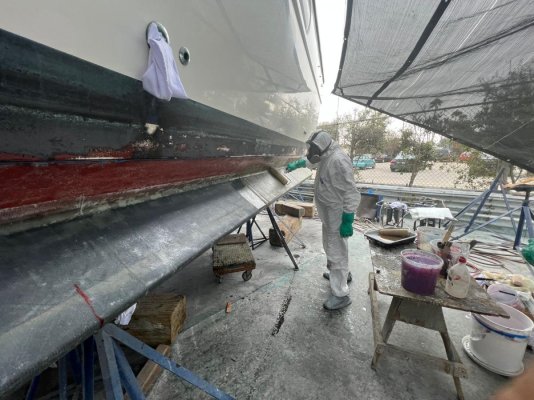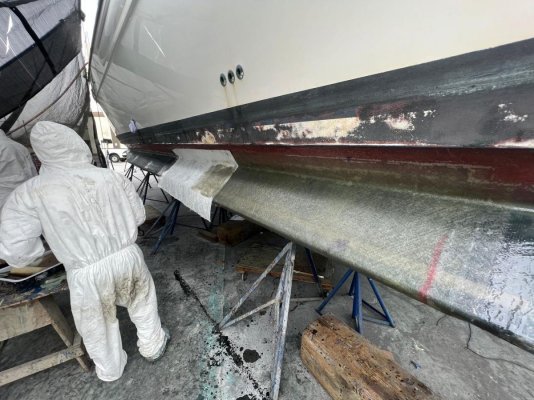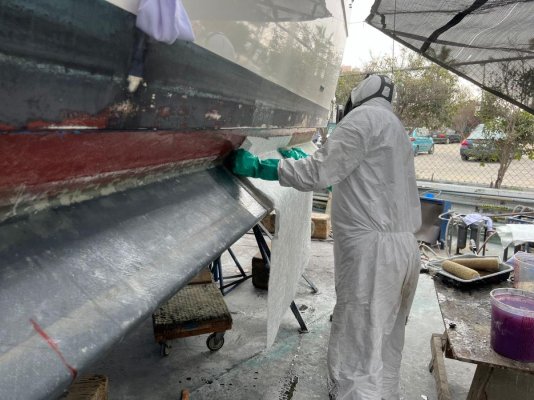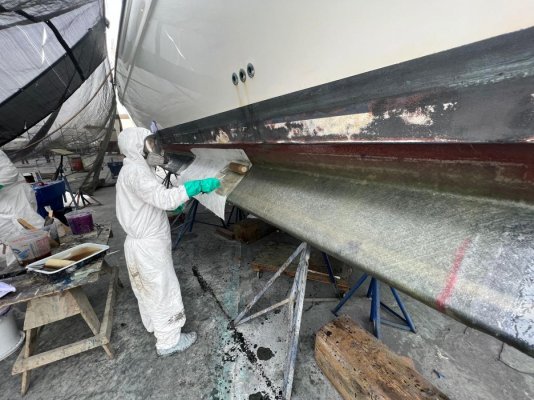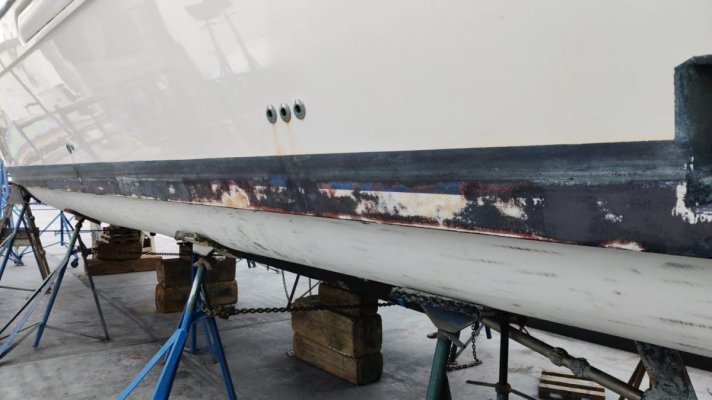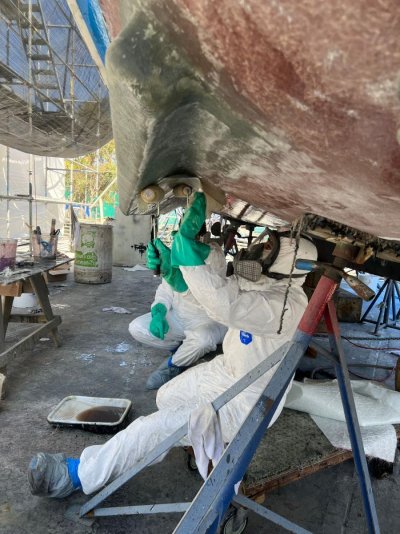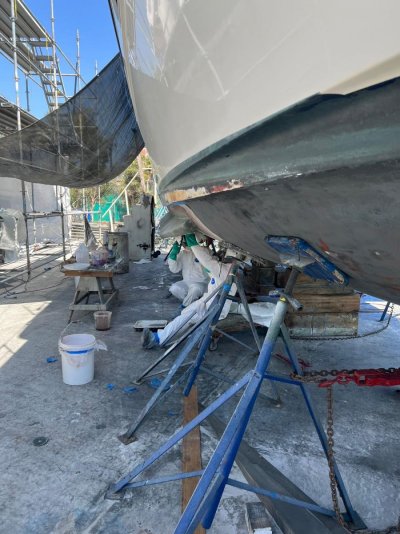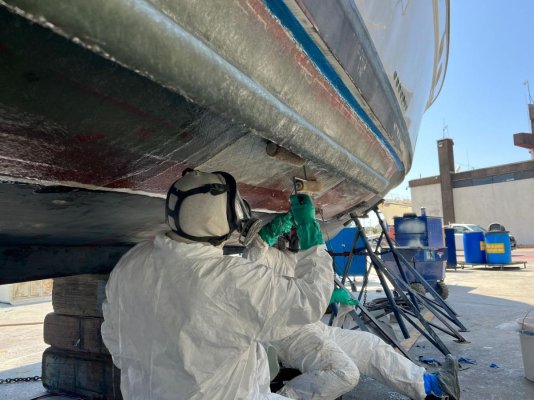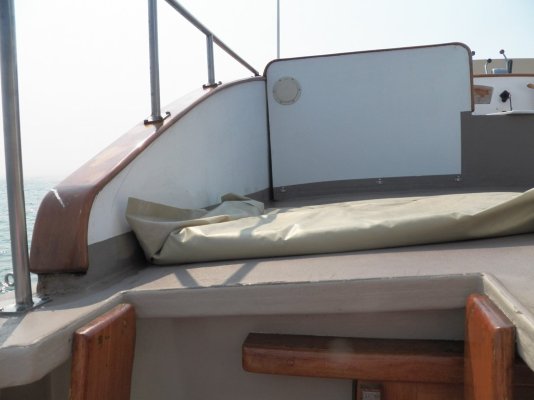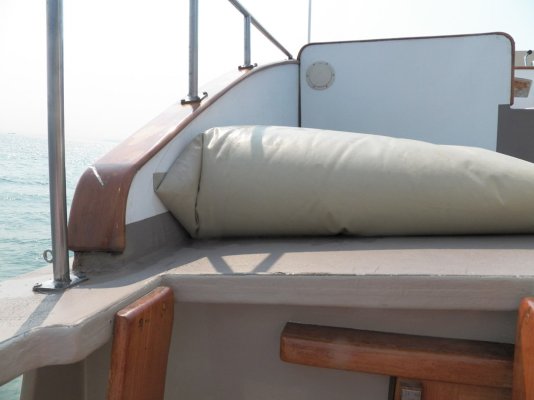You are using an out of date browser. It may not display this or other websites correctly.
You should upgrade or use an alternative browser.
You should upgrade or use an alternative browser.
Bilge Keel - Rolling Chock installation
- Thread starter ksanders
- Start date
The friendliest place on the web for anyone who enjoys boating.
If you have answers, please help by responding to the unanswered posts.
If you have answers, please help by responding to the unanswered posts.
ksanders
Moderator Emeritus
Reading through this post I saw 1 mention of cost, but no specific numbers.
Can the dollar amounts be mentioned for the project?
Thanks.
Yes, they estimated the cost of the project at $12,000 USD.
The estimate is just that, I am being billed for actual materials and labor.
Here are a few photos of the work today
Attachments
Steel N Time
Veteran Member
- Joined
- Dec 8, 2020
- Messages
- 44
Yes, they estimated the cost of the project at $12,000 USD.
The estimate is just that, I am being billed for actual materials and labor.
Here are a few photos of the work today
I assume that is the “work” not the haul out and daily yard fees?
Personally seeing this would frustrate me a little as the owner of this vessel. This conversation has focused around the strength of the bond to the hull. I’ve done quite a bit of fiberglass repairs myself and the chemical bond you typically want to grind down to the glass, so you are bonding glass to glass. Looks like they barely removed the black bottom paint and are glassing on top of reddish paint/gel coat? The chemical bond is best getting down to original glass, then glassing to that.
It’s all good that they will lift it in the yard when it’s brand new and that will be the initial “test”, but have a lot of time pounding in the ocean, flexing, vibrating, and down the road how will this bond be?
I suppose it will be easily repairable if something cracks, and the Coosa core is impervious to water, so it won’t be major.
On a round bilged hull you would want the chocks aligned with the diagonals as a first guess, not the waterlines. On a soft or hard chined boat, the chine is designed to be parallel with the assumed flow (at least in a FD or SD hull) so aligned with the chine is as close as the designer knows.
On my AT34, the total cost was $4000 not including the haul.
On my AT34, the total cost was $4000 not including the haul.
Steel N Time
Veteran Member
- Joined
- Dec 8, 2020
- Messages
- 44
On a round bilged hull you would want the chocks aligned with the diagonals as a first guess, not the waterlines. On a soft or hard chined boat, the chine is designed to be parallel with the assumed flow (at least in a FD or SD hull) so aligned with the chine is as close as the designer knows.
On my AT34, the total cost was $4000 not including the haul.
Your vessel is substantially smaller, you don’t make mention of how wide and how thick yours are comparatively, so the comparison doesn’t do much. Did you use Coosa as well?
Also how long ago was that? Pre-scamdemic I was paying $105.00 for 5 gallons of marine resin, my shipment two weeks ago I was charged $190 per 5 gallons, same resin, same supplier. Coosa nearly doubled as well. The sheet of 1/2” Coosa 2 weeks ago cost me $195.00.
I’m guessing part of his costs are due to the fleecing of America when supply chain issues caused everyone to raise prices and now that there is no supply chain issue, they still holding their high prices.
ksanders
Moderator Emeritus
I assume that is the “work” not the haul out and daily yard fees?
Personally seeing this would frustrate me a little as the owner of this vessel. This conversation has focused around the strength of the bond to the hull. I’ve done quite a bit of fiberglass repairs myself and the chemical bond you typically want to grind down to the glass, so you are bonding glass to glass. Looks like they barely removed the black bottom paint and are glassing on top of reddish paint/gel coat? The chemical bond is best getting down to original glass, then glassing to that.
It’s all good that they will lift it in the yard when it’s brand new and that will be the initial “test”, but have a lot of time pounding in the ocean, flexing, vibrating, and down the road how will this bond be?
I suppose it will be easily repairable if something cracks, and the Coosa core is impervious to water, so it won’t be major.
Nope, they removed everything down to the bare glass. What you are seeing as a reddish hue is the fiberglass after it was cleaned with MEK to remove any imbedded particles of fiberglass dust.
I am not worried even one bit.
This is not the first boat they have installed them on. In fact they completed the install on another boat of a different model just this week.
The cost that was estimated included haul, block, and launch. There are no daily yard fees as long as we launch the boat as soon as the work is complete, and assuming I do not request work to be stopped for any reason.
Attachments
Last edited:
Steel N Time
Veteran Member
- Joined
- Dec 8, 2020
- Messages
- 44
Nope, they removed everything down to the bare glass.
I am not worried even one bit.
This is not the first boat they have installed them on. In fact they completed the install on another boat of a different model just this week.
Awesome! The other photos with the red color was deceiving.
ksanders
Moderator Emeritus
Awesome! The other photos with the red color was deceiving.
I haver to say that this boat yard is as professional as I've seen.
They have a nice office, the whole yard is cement, they have a couple large buildings for indoor work, a scaffolding shop, etc...
Their employees seem to be professionals, and they have all the right equipment.
Steel N Time
Veteran Member
- Joined
- Dec 8, 2020
- Messages
- 44
I haver to say that this boat yard is as professional as I've seen.
They have a nice office, the whole yard is cement, they have a couple large buildings for indoor work, a scaffolding shop, etc...
Their employees seem to be professionals, and they have all the right equipment.
That’s great! You find a lot of the others! Employees that have sniffed to much fiberglass! ?. I noticed the guy working is wearing safety gear! That’s a good sign.
Kit_L
Guru
- Joined
- Mar 12, 2016
- Messages
- 510
- Location
- Australia
- Vessel Name
- Suu Kyi
- Vessel Make
- Custom 40' catamaran
Joining this thread to hear Kevin's report of actual function. I made paravanes for our last boat, and they worked well, but chocks of ksander's kind are very popular in Queensland, and many commercial vessels have them.
A very interesting thread.
A very interesting thread.
Comodave
Moderator Emeritus
- Joined
- Jul 2, 2015
- Messages
- 22,186
- Location
- Au Gres, MI
- Vessel Name
- Black Dog
- Vessel Make
- Formula 41PC
Yes, they estimated the cost of the project at $12,000 USD.
The estimate is just that, I am being billed for actual materials and labor.
Here are a few photos of the work today
Ok, so $24K…
Sailor of Fortune
Guru
Ok, so $24K…
Your harsh dude.. Uncalled for in my opinion...
O C Diver
Guru
- Joined
- Dec 16, 2010
- Messages
- 13,217
- Location
- Fort Myers, Florida
- Vessel Name
- End Of The Line
- Vessel Make
- Trinka 10 Dinghy
For what it's worth, that's matt fiberglass cloth, not bi-axial cloth.
Ted
Ted
Comodave
Moderator Emeritus
- Joined
- Jul 2, 2015
- Messages
- 22,186
- Location
- Au Gres, MI
- Vessel Name
- Black Dog
- Vessel Make
- Formula 41PC
Your harsh dude.. Uncalled for in my opinion...
Did you see the 3 dots after the comment? That means I was kidding. Maybe your reaction was uncalled for?
Steel N Time
Veteran Member
- Joined
- Dec 8, 2020
- Messages
- 44
The term is chopped strand mat (CSM) compared to cloth definitely won’t have near the strength. CSM is used to build up thickness with moderate strength. I can only assume they intermittently used some higher ounce cloth in the layers to add strength.
ksanders
Moderator Emeritus
The term is chopped strand mat (CSM) compared to cloth definitely won’t have near the strength. CSM is used to build up thickness with moderate strength. I can only assume they intermittently used some higher ounce cloth in the layers to add strength.
Here's what I think...
They are professionals
They are spending my money with no limits as to the quality of the products used.
They chose the products they chose for reasons i pay them to understand.
I am not about to step into the middle of their reasoning. They do this every day for a living.
Steel N Time
Veteran Member
- Joined
- Dec 8, 2020
- Messages
- 44
I don’t doubt that. That’s why I made the assumption that they will use some higher ounce cloth between CSM layers. I was clarifying proper terminology for O C Diver.
As a side note… Lots of professionals do things a lot wrong! I wish we could expect that they always know, but the fact is many “professionals” do they wrong and have failures. Doctors, Lawyers, and fiberglass workers…
“Second opinions” are almost expected on high digit items. Don’t be naive to think because they did one before yours and they do this for a living that they can’t make a mistake or do things wrong. Not specific to your project, it’s all things. I can’t count the number times I had expectations let down by “professionals” that do things for a living.
As a side note… Lots of professionals do things a lot wrong! I wish we could expect that they always know, but the fact is many “professionals” do they wrong and have failures. Doctors, Lawyers, and fiberglass workers…
“Second opinions” are almost expected on high digit items. Don’t be naive to think because they did one before yours and they do this for a living that they can’t make a mistake or do things wrong. Not specific to your project, it’s all things. I can’t count the number times I had expectations let down by “professionals” that do things for a living.
guy with a boat
Guru
Here's what I think...
They are professionals
They are spending my money with no limits as to the quality of the products used.
They chose the products they chose for reasons i pay them to understand.
I am not about to step into the middle of their reasoning. They do this every day for a living.
Agreed. Those are good reasons to let them do their jobs without driving from the back seat.
Also, its very common to use CSM in at least the first layer and last layer for good reasons that are not necessary to go into here.
SteveK
Guru
- Joined
- Jul 5, 2019
- Messages
- 5,788
- Location
- Gulf Islands, BC Canada
- Vessel Name
- Sea Sanctuary
- Vessel Make
- Bayliner 4588
Kevin, do they mind being photgraphed, I think not. Perhaps they would be equally willing to answer your "novice" questions on the glassing in progress. Ask them about the mat. Better to get it out of the way before the gel coat dries.
Kit_L
Guru
- Joined
- Mar 12, 2016
- Messages
- 510
- Location
- Australia
- Vessel Name
- Suu Kyi
- Vessel Make
- Custom 40' catamaran
I should have added to my short post that rolling chocks have some massive advantages over paravanes, including being much less likely to pick up debris, and are deployed 100% of the time. Most likely, they are not as effective as paravanes, but ease of use might outweigh ultimate effectiveness. I only used our paravanes when well offshore and on longer or very windy passages. Retrieving paravanes can be tricky when it's rough. I will definitely be investigating rolling chock on the next monohull. Thanks for starting this thread, @ksanders.
Another comment is that in Queensland metal is used on wooden boats too. Some of the approaches can be seen here: https://rlmarine.com.au/stabilisers/
Another comment is that in Queensland metal is used on wooden boats too. Some of the approaches can be seen here: https://rlmarine.com.au/stabilisers/
ksanders
Moderator Emeritus
Kevin, do they mind being photgraphed, I think not. Perhaps they would be equally willing to answer your "novice" questions on the glassing in progress. Ask them about the mat. Better to get it out of the way before the gel coat dries.
nope, no problem at all being photographed.
I'll ask about their planned layup schedule on Monday.
Fiberglass to me is sorta PFM. I understand the concepts but that's it.
I have not watched every layer go on. I am assuming that they are adding strength layers either in between matt layers, or that they are building up a smooth base and will apply fabric over that.
What I do know is that what they have done so far has changed the fins from looking like appendages to looking like they belong on the boat. The build up is smoothing out the whole look.
Monday I'll know, because I'm curious.
Last edited:
ksanders
Moderator Emeritus
The work is continuing.
They are layering fiberglass matt and cloth to create a strong structure.
Before painting they will fare-feather out the leading edge to create a smooth transition and minimize any drag.
One thing is clear to me. These are not stick on bilge keels. Not that there was a problem before, but this hull is going to be a lot stiffer with the addition of this amount of fiberglass.
The photos show the thickness at the leading edge.
The units are 24' long X 12" deep. There is a 2' taper to the leading edge.
We are anticipating a launch next week.



They are layering fiberglass matt and cloth to create a strong structure.
Before painting they will fare-feather out the leading edge to create a smooth transition and minimize any drag.
One thing is clear to me. These are not stick on bilge keels. Not that there was a problem before, but this hull is going to be a lot stiffer with the addition of this amount of fiberglass.
The photos show the thickness at the leading edge.
The units are 24' long X 12" deep. There is a 2' taper to the leading edge.
We are anticipating a launch next week.
Attachments
-
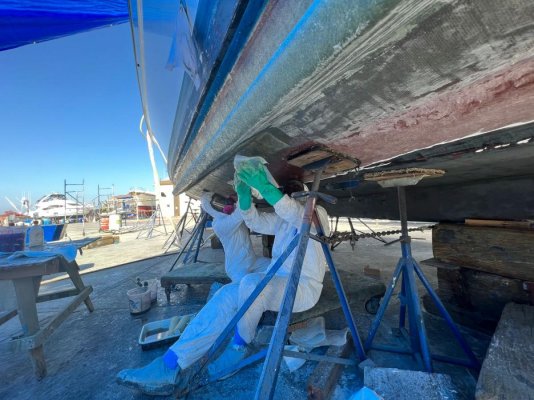 5638A658-054C-453D-8C9E-2D2E419B8A29.jpg171.7 KB · Views: 46
5638A658-054C-453D-8C9E-2D2E419B8A29.jpg171.7 KB · Views: 46 -
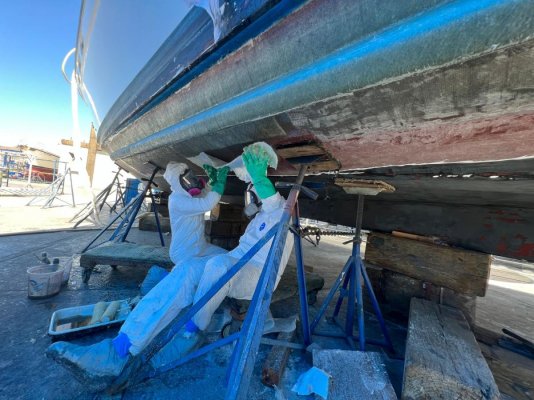 CBD776EA-2BDE-433A-B023-F1DDC43C1D51.jpg178.2 KB · Views: 51
CBD776EA-2BDE-433A-B023-F1DDC43C1D51.jpg178.2 KB · Views: 51 -
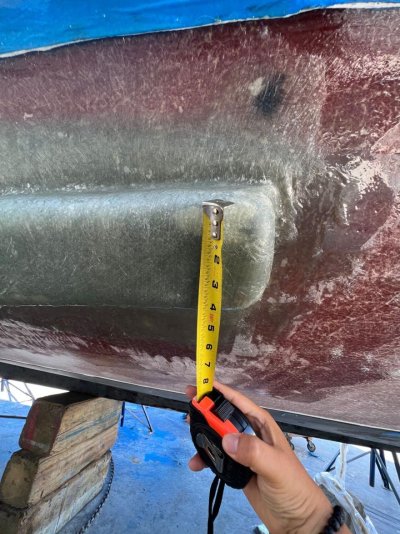 78A026DC-07C6-4C87-BF3C-EAF1DA30D082.jpg193.5 KB · Views: 47
78A026DC-07C6-4C87-BF3C-EAF1DA30D082.jpg193.5 KB · Views: 47 -
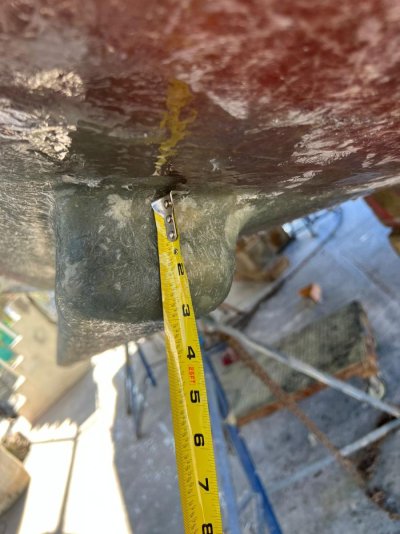 CCF2B815-DFD8-488A-830A-2667C674E68D.jpg124.1 KB · Views: 44
CCF2B815-DFD8-488A-830A-2667C674E68D.jpg124.1 KB · Views: 44 -
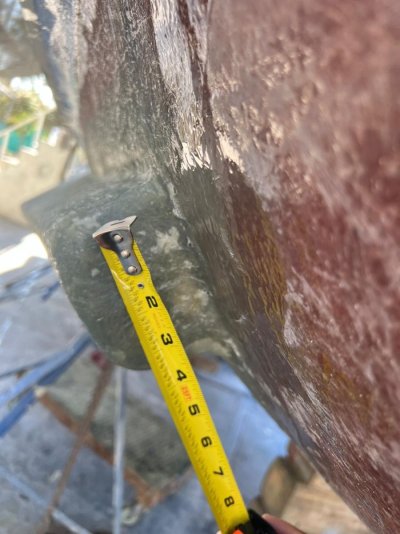 FB4F76E1-53B7-4C88-B677-21B1D87F367C.jpg114.9 KB · Views: 43
FB4F76E1-53B7-4C88-B677-21B1D87F367C.jpg114.9 KB · Views: 43 -
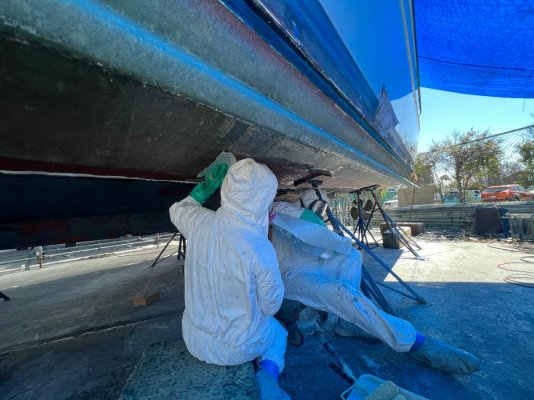 4EC27558-B835-41E2-A4E6-76F53552EC6A.jpg156.2 KB · Views: 44
4EC27558-B835-41E2-A4E6-76F53552EC6A.jpg156.2 KB · Views: 44
Last edited:
Comodave
Moderator Emeritus
- Joined
- Jul 2, 2015
- Messages
- 22,186
- Location
- Au Gres, MI
- Vessel Name
- Black Dog
- Vessel Make
- Formula 41PC
Looking good, let us know how they work.
ksanders
Moderator Emeritus
The fiberglass work continues.
To date they have used right at 40 gallons of resin.
We are launching next week.
To date they have used right at 40 gallons of resin.
We are launching next week.
Attachments
Comodave
Moderator Emeritus
- Joined
- Jul 2, 2015
- Messages
- 22,186
- Location
- Au Gres, MI
- Vessel Name
- Black Dog
- Vessel Make
- Formula 41PC
Bet you are excited.
ksanders
Moderator Emeritus
What are your expectations for roll reduction, either quantitative or qualitative?
Good question...
I expect the synchronous roll to be dampened considerably.
My definition of synchronous roll is the boats tendency to in a visually minor beam swell to start a rolling motion that increases with each swell to the point where is is very violent.
Along those lines I am expecting that the absolute roll angle will be somewhat reduced, and rolling to be shorter in duration for example from a passing wake.
What I am hoping for but am not sure will happen is that the roll period will increase from it's present less than 4 seconds to something longer. I honestly do not know if the rolling chocks will change that hull attribute.
Of course the goal is more comfort, but how do we define that in a non subjective manner?
before i left the dock to get the rollng chocks installed I shot a video of me inducing a serious roll using my body weight to pull the boat downward several times.
When i return to the dock before I take on water or fuel I will shoot the exact same video.
This will be the only quantitive measurement possible. The rest will be my perceptions. I'll report what I find and am not one to self justify my project by exagerating the positive side.
Marco Flamingo
Guru
- Joined
- Jan 7, 2020
- Messages
- 1,173
- Location
- United States
- Vessel Name
- CHiTON
- Vessel Make
- Tung Hwa Clipper 30
My definition of synchronous roll is the boats tendency to in a visually minor beam swell to start a rolling motion that increases with each swell to the point where is is very violent.
Along those lines I am expecting that the absolute roll angle will be somewhat reduced, and rolling to be shorter in duration for example from a passing wake.
What I am hoping for but am not sure will happen is that the roll period will increase from it's present less than 4 seconds to something longer. I honestly do not know if the rolling chocks will change that hull attribute.
Of course the goal is more comfort, but how do we define that in a non subjective manner?
I was able to get some "data" on the effectiveness of my anti-roll bag when crossing from Friday Harbor to Point Wilson on Wednesday. For those of you familiar with this passage, you have probably experienced the swell that comes down the Straight of Juan de Fuca on your beam. The weather was nice and calm at the moment but it had blown west 15-20 for a few days prior. Probably a 2 foot swell.
I emptied the bag and then used my onboard potable water to refill it during testing. When emptied, my inclinometer showed fairly regular 3 to 4 degree rolling. When the synchronous roll got going, we had an occasional 10 degree, always followed by an opposite 9 degree and then tapering off back to the "baseline" 3-4 degree rolls. 2-3 is okay, 9-10 isn't really, even with everything battened down.
I took the hose up to the FB (after the wife made me put on my PFD) and filled the bag. Because of the occasional 10 degree rolling, I had to get on my hands and knees. Not pleasant up there and the PFD was a good idea. Kind of wet because the fill is near one end of the bag and when the boat rolled it would squirt back at me. I probably used 30 gallons to fill 20. Going back below, my wife said she hadn't seen a 10 degree in a while. Maximum was now 6 degrees, as it didn't seem to be able to build to a 10 degree roll. And a 6 degree roll was always followed by a 4 degree (a 2 degree drop instead of 1 degree), shutting down any synchronous rolling much faster. 1-3 degree rolls were now the most common.
It felt odd looking out to the side of the boat to make sure I got the most roll out of an oncoming swell, and then watching the inclinometer for the one second that mattered. Also, not quite as scientific as I would like. During a crossing of the Straight, the current changes, the wind speed and direction changes, etc., so not too accurate. Plus, I had moved the water from the starboard tank in the lazarette to the FB. But from a purely subjective point of view, a couple of degrees less, a couple of rolls less, and maybe a fraction of a second less in roll period can make things more comfortable. It doesn't seem to take much. Happy wife, happy life.
I took some video, but don't think I can post it here. These still shots show the basics. The first picture shows the bag with most of the water out of the picture to the right, even though the boat is starting to take a roll to the left. Just after the roll to the left is complete, the water arrives (about 200#) with a surprising punch, suppressing what would be a snappy return roll and maybe a synchronous building roll. (The stress cracking on the cowling gel coat was already there. It isn't that much of a punch.)
Attachments
ksanders
Moderator Emeritus
I was able to get some "data" on the effectiveness of my anti-roll bag when crossing from Friday Harbor to Point Wilson on Wednesday. For those of you familiar with this passage, you have probably experienced the swell that comes down the Straight of Juan de Fuca on your beam. The weather was nice and calm at the moment but it had blown west 15-20 for a few days prior. Probably a 2 foot swell.
I emptied the bag and then used my onboard potable water to refill it during testing. When emptied, my inclinometer showed fairly regular 3 to 4 degree rolling. When the synchronous roll got going, we had an occasional 10 degree, always followed by an opposite 9 degree and then tapering off back to the "baseline" 3-4 degree rolls. 2-3 is okay, 9-10 isn't really, even with everything battened down.
I took the hose up to the FB (after the wife made me put on my PFD) and filled the bag. Because of the occasional 10 degree rolling, I had to get on my hands and knees. Not pleasant up there and the PFD was a good idea. Kind of wet because the fill is near one end of the bag and when the boat rolled it would squirt back at me. I probably used 30 gallons to fill 20. Going back below, my wife said she hadn't seen a 10 degree in a while. Maximum was now 6 degrees, as it didn't seem to be able to build to a 10 degree roll. And a 6 degree roll was always followed by a 4 degree (a 2 degree drop instead of 1 degree), shutting down any synchronous rolling much faster. 1-3 degree rolls were now the most common.
It felt odd looking out to the side of the boat to make sure I got the most roll out of an oncoming swell, and then watching the inclinometer for the one second that mattered. Also, not quite as scientific as I would like. During a crossing of the Straight, the current changes, the wind speed and direction changes, etc., so not too accurate. Plus, I had moved the water from the starboard tank in the lazarette to the FB. But from a purely subjective point of view, a couple of degrees less, a couple of rolls less, and maybe a fraction of a second less in roll period can make things more comfortable. It doesn't seem to take much. Happy wife, happy life.
I took some video, but don't think I can post it here. These still shots show the basics. The first picture shows the bag with most of the water out of the picture to the right, even though the boat is starting to take a roll to the left. Just after the roll to the left is complete, the water arrives (about 200#) with a surprising punch, suppressing what would be a snappy return roll and maybe a synchronous building roll. (The stress cracking on the cowling gel coat was already there. It isn't that much of a punch.)
Wow!!!
Please tell more about your anti roll bag!
I remember your posting about it a bit, but do not know how to search well
I’m interested as well. Bag material, how assembled, etc…
I like the bag idea cause it can be rolled and stowed when not in use. Plus, it could be a huge solar shower.
Might be just what you need Kevin, for taking those beam seas if you decide to hug the coast.
I like the bag idea cause it can be rolled and stowed when not in use. Plus, it could be a huge solar shower.
Might be just what you need Kevin, for taking those beam seas if you decide to hug the coast.

